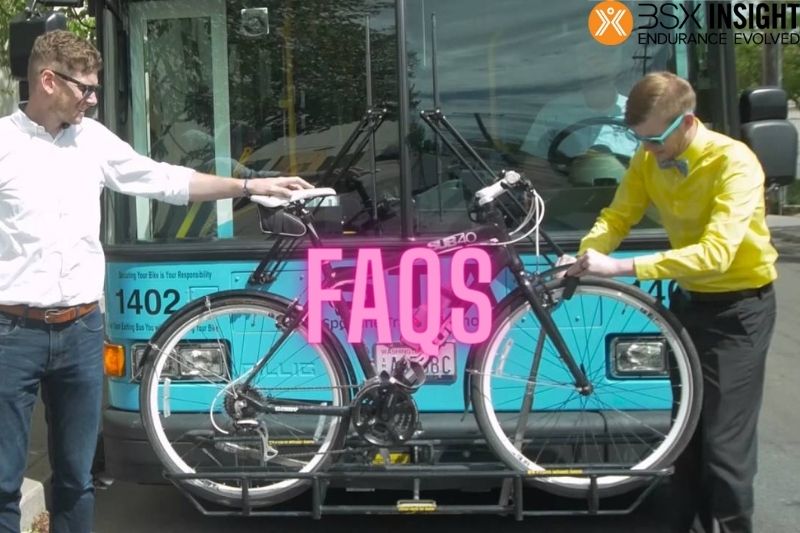Bicycles are popular among many people because of their convenience and efficiency. It gets trickier, though, if you need to go a long way out of your way.
Typically, city buses will have a rack for bikes at the front of the vehicle.
Bsxinsight will show you How to put bike on bus and what types of bikes you can take on buses in this article.
How To Put Bike On Bus? Step-By-Step

Remove large baggage
Get to the bus stop early so you have time to load your bike while you wait for the bus. Take off your bike’s water bottles, pump, panniers, and anything else that could fall off and cause an accident. Your bike might not be able to fit on the rack if you don’t.
- Don’t forget to bring a backpack to carry your extra gear and personal belongings while you ride. You need both of your free hands to lift your bike onto the rack.
- Extra bags have to be brought on the bus with you. There is no way to secure your bag to the bike’s rack or frame.
Alert the bus operator that you will be loading your bicycle
Step right up onto the bus from the curb. Please alert the bus driver that you will be loading your bike before approaching the vehicle. To cross in front of the bus, wait for the driver to signal that it is safe to do so.
Lower the rack by squeezing the center handle

By applying pressure to the handle, the locking pin can be removed. This step is only required if no other bicycles are currently stored on the rack. If there are other bicycles already mounted on the rack, it will automatically lower for you if you try to mount your own.
Lift your bicycle, so it sits in the empty wheel well
Both the seat tube and the stem of a bicycle are considered tubes. The seat tube is located directly beneath the seat, and the stem is a horizontal bar that connects the front and rear wheels.
Put one hand on each of the designated areas, and lift the bike using your arms. When you are holding the bike in this position, you have the most leverage and stability available to you.
Pull the spring-loaded support arm out and upwards
Extend the arm fully before lifting it up and over the front tire. Check that the stabilizing arm is snug against the front wheel’s leading edge. It should not be supported by the fender or the brake.
On some racks, you must press a button on the arm’s end to release it and then pull it out. If pulling on the arm does not move it, locate the release button and press it.
Utilizing your own lock, secure your bicycle to the rack.
Board the bus. Pay your fare
The bus should be taken, and the fare should be paid for, as usual. Bike rack installation is included in the price. If you sit in the front of the bus, you won’t have to worry about anyone else touching your bike. Even when your bike is at a stop, you should never take your eyes off of it.
When you come to your stop, exit the bus at the front
Get the bus driver’s attention now and tell him or her that you need to remove your bike from the rack. Give them a nod or a point to the rack as a gentle reminder. Pay attention to the driver as you do this. Stepping in front of a bus without first making eye contact with the driver is a bad idea.
If no other bicycles remain, stow the rack against the bus in the upright position.
If your bike was the only one attached to the rack, squeeze the handle and then fold the rack back up. Remove your bike from the fitted slots and step away from the rack if there are other bikes on the rack.
Rules for Bringing a Bike On Bus

- As a bus approaches, stand near the bus stop sign while waiting at a bus stop with your bike.
- You are not permitted to lock your bicycle to the front rack of a bus. If you want to be extra safe, simply lock your front wheel to the frame of your bike before the bus arrives.
- Use the closest available rack position to the bus.
- After mounting your bike, give it a quick shake to ensure it’s securely in place.
- Non-standard bikes that are tall enough to obstruct the view of the bus operator, recumbent bikes, tandem bikes, or bikes that will not fit into the rack are not permitted on the bus. Flags and poles that protrude from the bicycle are not permitted. Motorized bikes are also not permitted. We appreciate your assistance.
- Folding bikes should be folded and transported on the bus.
- When riding your bike on a bus, ride near the front and exit through the front door (we know, this is the opposite of how we usually ask you to move to the back). This allows you to keep an eye on your bicycle and notify the driver when you want to exit the bus and remove your bike from the rack.
- If you notice a problem with a rack, notify the bus operator and wait for the next bus—best it’s for everyone’s safety (and your bike’s!).
- If you require assistance, the bus driver may refuse to load your bike. They may, however, offer you advice or directions as you mount your bike.
What’s The Type of Bikes Can Put On Buses?

Bikes allowed
Regular old one-person, two-wheeled bicycles. For a bike to be used with a bike rack, both of its wheels must be able to fit into the rack’s wheel slots, and the rack’s support arm or hook must be (fenders ok).
You may bring a folded bike on the bus with you, but it must be able to fit underneath your seat and out of the aisle.
Constraints on height and mass apply. Securely stored on the rack are bikes of the following sizes:
- Spoke and rim diameters between 16 and 29 inches
- Maximum 46-inch wheel base.
- You can use tires with a width of up to three inches.
Each rack space can only hold up to 55 pounds of weight (including any bike accessories). This limit is easily exceeded by many electric-assist bicycles. The bus allows passengers to bring in external batteries.
Bikes not allowed
Metro does not allow any bikes or scooters (even folded ones) on buses for safety reasons. But other bus companies could allow folded bikes.
Tandem recumbents, cargo bikes, three-wheelers, solid-wheeled bikes, and other devices with tires wider than 3 inches will not fit on the racks because they exceed the size and weight restrictions listed under Bikes Allowed.
They are unable to accommodate gas or other non-battery-powered bicycles at this time. A large percentage of modern electric-assist bicycles weigh more than 55 pounds.
Attachments that go over the front wheel and get in the way of the support arm mean that certain bikes will not fit. Some examples of such accessories are baskets and handlebar packs.
No attachments or add-ons are allowed if they could cause:
- Stop another bike from being loaded, or cause damage to the one next to it.
- Expend unnecessary energy, create visual clutter, or endanger people in other ways by breaking free and flying away.
- Block the driver’s view of the turn or brake lights.
- Cover the driver’s eyes to prevent accidents. Nothing should be mounted on a bicycle if it will make the total height of the mount exceed the height of the handlebars.
- Baskets made out of milk cartons and most types of child seats are examples of items that are not allowed.
FAQs
Can you lock your bike to the bus?
No. You should not lock your bike on the bus. Just leave your bike on the rack, it is enough to hold your bike.
How do you put your bike on the TTC bus?
- When boarding a bus, it is preferable to do so from the curb rather than from the street.
- Do not stand in the street; instead, place your bicycle on the sidewalk and wait for the bus to come to a full stop before entering the roadway. It’s possible that a flashing light will be used to signal for a bus when it’s late and dark.
- Get off your bike and bring any bags or water bottles with you that are hanging from it.
- You will not need to speak to the bus driver in order to secure your bicycle on the rack. However, as you move in front of the bus to load your bike, be sure to make eye contact with the driver of the bus.
- It is against the rules for the driver of the bus to get up out of his or her seat in order to help you load.
Conclusion
Thanks for reading! We hope this guide helps you to put the bike on the bus. Everything will be easier over time if you are willing to learn and master it. Be sure to check out for more content about bikes, healthy lifestyles, and fitness equipment.


